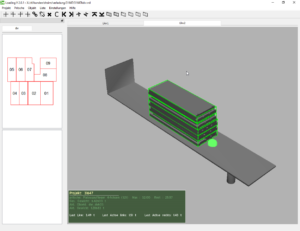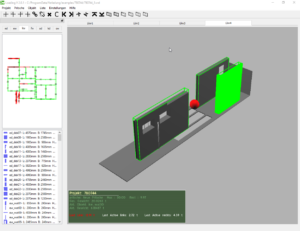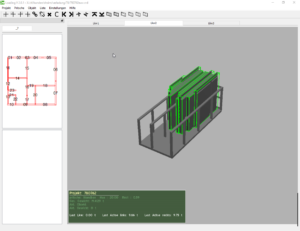They are only used at the end of the production chain and are nevertheless elemental:
Efficient loading solutions and functional transportation logistics can significantly increase the production success.
As part of their MES solutions (Manufacturing Execution System), the granIT software developpers have designed an attractive solution method using computer geometry and operations research– and this is not only suitable for the prefabricated houses industry!
granIT:loading • For whom and what exactly?
The optimum placement of a load (for example on a semi-trailer or semitrailer and / or a truck with flatbed body) makes the best possible use of the cargo hold in the economic and logistical sense, ensures the correct order during unloading and thus facilitates the process of further use of the load – this requirement is quite easy to meet, for example, for standardized general cargo in small to medium sizes and weight classes. It gets more complicated when large, differently heavy parts are loaded in various geometries and have to be unloaded in optimum order at a later point. If, for example, a wall or a roof gable is not delivered in the right time, sequence and in the appropriate batch while building a prefabricated house, the entire construction process will come to a halt and unnecessary downtime arises.

granIT:loading: Smart solution for more efficiency
This is where granIT:loading starts:
The software, configurable to almost any customer requirement, enables optimally spaced and sensibly placed cargo on all modes of transport regarding the appropriate space available. Previously defined parameters, such as weight and geometry of the load in relation to the dimensions and performance of the means of transport are regarded.
The exact position and orientation of the load on the vehicle or trailer is displayed three-dimensionally.
granIT:loading • Focus on the weight
The weight data of the individual load parts and the vehicles to be loaded should be entered first. Using an own vehicle fleet or always the same vehicle types, standard values can, of course, be entered. In addition, legal guidelines for the countries to approach must be taken into account. For example, there are lower load limits in Switzerland than in Germany. If the limits that were previously defined in the program are exceeded while virtually loading the vehicle, corresponding warning information will appear.
Weight can also play a role when loading a transport vehicle regarding terms of space. For example, if the walls of prefabricated houses are made of concrete, the permissible payload weight of the vehicle is reached quickly – but the available area is not yet fully occupied. In such cases, a clever distribution on several vehicles is essential.
Speaking of distribution – the majority of the load weight may not be on the tractor or on the axles. Depending on the vehicle type, additional weight distribution regulations must be observed.

granIT: loading works with a graphic ball which signals in green colour an optimum distribution of the weight and always turns to red when an imbalance was recorded or too much weight is placed on certain areas of the loading area.

granIT:loading • Geometry of objects
Just like the weight, the geometry of the parts to be loaded must be regarded by the program. For example at the prefabricated house construction sector: slabs, walls and ceilings without attachments or protrusions can be stored relatively simply, standing close to each other or lying one on top of the other. It becomes trickier if, for example, window sills are attached. Since these protrude out of the wall, you can not put two walls up and side by side. The corresponding parameters and dimensions can, however, be entered in the granIT: loading program, so that the necessary distances are maintained when the vehicle is loaded virtually. In principle, almost every geometry of a part to be loaded can be taken over by granIT: loading. The correspondingly optimum arrangement of the respective parts on the loading surface is carried out manually with the support of the software and according to predetermined parameters.

On some vehicles loading aids such as for example pickup rods are used. Depending on the type of vehicle and the layout of the loading area, these can be used at different positions in the cargo hold. Their dimensions and positions can also be taken into account by granIT: loading in order to tie unstable, voluminous parts to it at a later point. This prevents wobbling, dislocation or shifting of the load. The hole pattern for the poles to be installed can also be included in the program – click on one of the pole holes and pick up the loading poles there.
granIT:loading • Everything in sight
The loading plan is displayed in three dimensions and in real time as well as all individual work steps. During the virtual loading process, all graniT: loading parts can be moved or deleted by the user via drag & drop. In addition, updated content lists are displayed for each truck.
As with many granIT software solutions, the user also plays a central role in granIT: loading. The program has, for example, no standardizing automatisms as it was specially designed for the use of unusual, individually configurable parts.
Accordingly, the strength of granIT: loading is its individual applicability. In principle, all loading geometries, weights and vehicle types can be generated by the granIT developpers for the application with granIT: loading and can be introduced into the software.

